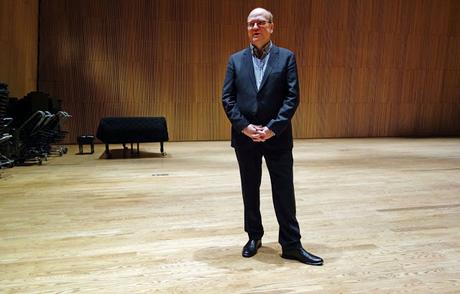by Paul J. Pelkonen

Where's the orchestra? Conductor Bernard Labadie stands alone.
Photo © 2019 Orchestra of St. Luke's
When an orchestra brings in a new music director, there is always a shift in terms of programming and focus. Consider if you will the Orchestra of St. Luke's that outstanding and flexible ensemble that gives regular concerts at Carnegie Hall, and its new boss Bernard Labadie. On Thursday night, the Orchestra played a program of Haydn, Mozart and Beethoven, celebrating the virtue of all things right, proper and classically structured.
The evening began with a Haydn rarity: the overture to his opera L'Isola Disabitata. Haydn wrote twenty operas in the course of his long employment by the Prince Esterhàzy, keeping up with his music-loving boss' constant demand for new and innovative music. This one is from 1779 and boasts a series of engaging melodies and a sculpted, perfectly formed sound, replete with ornamentation and invention that looks back to the high baroque.
Mr. Labadie conducted this work in an unusual position: a piano bench perched atop the usual podium. One assumes this allowed him the familiar comforts of one who conducts mostly from the keyboard, while still allowing the orchestra to see his gestures and cues. The musicians responded with razor-edge precision, zipping through the perfectly formed architecture of the work with the enthusiasm of archeology students.
The orchestra was joined by Jonathan Biss for the Beethoven Piano Concerto No. 2, as a substitute for the injured Paul Lewis. (This is the second time that Mr. Biss has stepped in to play Beethoven at Carnegie Hall this season, making the pianist the venue's own "utility infielder" in the composer's work.) This performance of the concerto was gracious and delicately accompanied, with Mr. Biss' dexterous technique on full and vivid display.
The second half had a much more interesting guest: soprano Ying Fang. Ms. Fang was the leading lady of the Juilliard Opera for the last few years that she was at the conservatory. Judging from this performance of "Non temer, amato bene", a Mozart aria that is only included in the Vienna edition of the opera Idomeneo, she is headed for better and bigger things. The singer displayed sweet tone and faultless control through the difficult coloratura, accompanied by Lukes' concertmaster Krista Benion Feeney in a prominent solo violin part.
The story of how Haydn, in 1772 answered the excessive labor demands of his patron with his Symphony No. 45 is a familiar one but it bears recounting here. Composr and musicians had worked an especially long season at the Esterhàzy Palace, and wanted to go home to their wives and families. The orchestra was threatening to up and quit, but Haydn got the message across with this piece, which features the musicians slowly getting up and leaving during the final movement, letting the work end with just two violins tracing out the final notes.
The musicians tore into the opening Sturm und drang movement, charging wholeheartedly into the perfect sonata form with a combination of abandon and technical restraint. The two middle movements were delicate court dances, as if to lull the audience for the fireworks to come. The first half of the finale surged in a similar manner before the famous "walkout". The hall darkened and the players began their exodus. Even Mr. Labadie left before the final notes were played, leaving his piano bench seat looking curiously forlorn as the house lights faded to black.
If you enjoyed this article, it's time to click over to Superconductor's Patreon page, and help support the cost of independent music journalism in New York City at the low cost of just $5/month.

